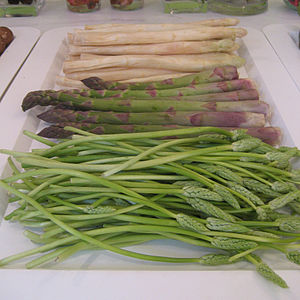1. In a Class All its Own
The asparagus plant was originally part of the lily family, the Liliaceae, like onions and leeks but was recently moved to the Asparagales classification.
2. It’s All Greek to Me
Asparagus, whose name comes from asparagos, the Greek word for shoot, has been used since ancient times. Thought to cure everything from heart problems to toothaches, early records from Greece and Rome outline its many medicinal uses.
3. Grows like a Weed
Grown from a crown planted in sandy soil, asparagus spears can grow as much as 10” in 24 hours. Spears are sent up from the crown in late spring and early summer and can be harvested for about 6-8 weeks. Toward the end of the picking season, spears may require daily harvesting to keep up with growth.
4. Perennial and Pretty
Once the picking season ends in mid-summer, the spears change over to ferns that produce red berries for the remainder of the season. This allows the crown to gather the nutrients required to support the initial growth next season. With proper care and conditions, an asparagus plant can produce a harvestable crop for 15-20 years.
5. In this Case, Bigger is Better
Diameter is a key indicator of quality. When choosing spears, you should select those with the largest diameter and the most vibrant color (the greenest if it is green asparagus and the whitest, if it is white).
6. Naturally Nutritious
Asparagus is a nutritional powerhouse that provides a big bang for the buck. Loaded with folic acid, potassium, vitamins A, C and B6, rutin, thiamin and fiber with no fat or cholesterol and very little sodium, the vegetable is only 20 calories for 5 ounces.
7. USA favorite
Even though the U.S. consumes more than 4 times as much asparagus as other countries, Peru is the leading asparagus exporter followed by Mexico and Canada. In the U.S., the majority of the asparagus is grown in California with Michigan and Washington lagging behind.
8. The Life Cycle of Asparagus
Beginning as a small black seed, Asparagus develops into long tube like roots and called a crown. Developed crowns, which take more than a year to establish, will send up spears in the second or third year of growth that can be harvested over a 6-8 week period. Once the picking season ends, the spears transition to a fern for the remainder of the summer gathering resources for next year.
9. Variety
There are more than 50 different types of asparagus to choose from including Mary and Martha Washington varieties and the three most popular colors; green, white and purple.
10. Bugs
The asparagus has two natural predators besides people. The first, is asparagus beetles, which eat the plant down to the roots. The second is asparagus rust, a fungus that grows on the spears.
Grab asparagus at the local farmers market and enjoy!
Related articles
- My Top 10 List of Summer Veggies (fillyourplate.org)
- More Ways to Eat Healthy & Stay on a Budget (fillyourplate.org)
- New recipes feature Arizona meat & produce (fillyourplate.org)



